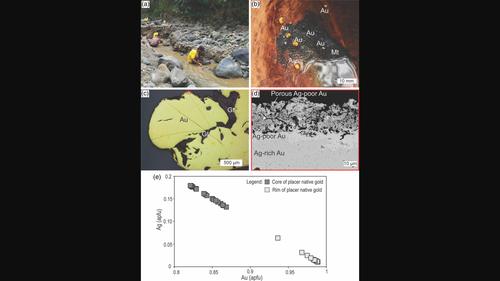当前位置:
X-MOL 学术
›
Resour. Geol.
›
论文详情
Our official English website, www.x-mol.net, welcomes your
feedback! (Note: you will need to create a separate account there.)
Primary source of placer gold in the Luk Ulo Metamorphic Complex, Central Java, Indonesia
Resource Geology ( IF 1.1 ) Pub Date : 2022-09-18 , DOI: 10.1111/rge.12300 Renaldi Suhendra 1 , Ryohei Takahashi 2 , Akira Imai 3 , Hinako Sato 2 , Nugroho Imam Setiawan 4 , Andrea Agangi 2
Resource Geology ( IF 1.1 ) Pub Date : 2022-09-18 , DOI: 10.1111/rge.12300 Renaldi Suhendra 1 , Ryohei Takahashi 2 , Akira Imai 3 , Hinako Sato 2 , Nugroho Imam Setiawan 4 , Andrea Agangi 2
Affiliation

|
The Luk Ulo Metamorphic Complex, Central Java is a product of the Cretaceous subduction and accretion, and includes diverse types of protoliths. Two-types of primary mineralization have been recognized in this area, namely, (1) seafloor basalt-hosted massive sulfide mineralization and (2) low-grade metamorphic rocks-hosted vein type mineralization. Later erosion of these types of primary mineralization formed placer gold deposits along rivers. However, the source has never been identified. Thus, this study aims at understanding the source of placer gold, the characteristics of the primary mineralization, and the tectonic evolution of the study area on the basis of mineralogy, mineral chemistry, whole-rock geochemistry, and sulfur isotope analyses. Volcanogenic massive sulfide (VMS)-type mineralization was identified in the seafloor basalt and few deep-sea sedimentary rocks, and both the ores and host rocks preserved pre-metamorphic textures and minerals. The characteristics of this VMS-type mineralization include (1) crustiform quartz veins with pyrite cutting the host rocks, (2) zonation of local silicification to interlayered chlorite/smectite-chlorite-laumontite-calcite-epidote alteration from central to outer zone, (3) pyrite-dominated ores with minor amounts of arsenian pyrite, chalcopyrite, and marcasite, (4) unmetamorphosed host rocks and ores, and (5) sulfur isotope signature with a median δ34S of +3.1‰ suggesting sulfur derived from magmatic source and/or sulfur extracted from basaltic rocks with a small contribution of biogenic sulfur. On the other hand, low-grade metamorphic rocks-hosted vein type mineralization was identified as orogenic-type gold mineralization, and the mineralized veins formed after the peak of metamorphism. It is characterized by (1) pyrite-arsenian pyrite ores with minor amounts of arsenopyrite, galena, tetrahedrite, chalcopyrite, and sphalerite, (2) quartz-illite-graphite alteration assemblage, (3) mineralized veins cross-cutting the foliation of metamorphic host rocks, (4) high antimony contents of pyrite (up to 1.7 wt%) and rutile (up to 160 ppm), (5) relatively high ore-forming temperature (423 ± 9°C, calculated from arsenopyrite and graphite geothermometers), and (6) remobilized-sedimentary sulfur signature of the ores with a median δ34S of −9.8‰. Several lines of evidence suggest that placer gold was likely derived from the erosion of orogenic-type gold ores in the surrounding areas. This evidence includes the presence of gold-bearing ores hosted by low-grade metapelites and metagranitoid with characteristics of orogenic-type gold mineralization, whereas the VMS-type ores are barren in gold. The occurrence of the mid-oceanic ridge- and accretion zone-related mineralization in this area reflects the subduction and amalgamation of oceanic and continental crustal blocks during the Cretaceous period. Discovery of gold mineralization hosted in the Cretaceous basement rocks of the Sunda arc indicates the importance to broaden the gold exploration targets to include not only young volcanic rocks, but also relatively old metamorphic basement rocks.
中文翻译:

印度尼西亚中爪哇 Luk Ulo 变质复合体中砂金的主要来源
中爪哇的 Luk Ulo 变质复合体是白垩纪俯冲和吸积的产物,包括多种类型的原岩。该区已识别出两种原生矿化类型,即(1)海底玄武岩型块状硫化物矿化和(2)低品位变质岩型脉型矿化。这些类型的原生矿化的后期侵蚀形成了沿河流的砂金矿床。然而,源头一直未查明。因此,本研究旨在在矿物学、矿物化学、全岩地球化学和硫同位素分析的基础上,了解砂金的来源、原生矿化特征以及研究区的构造演化。在海底玄武岩和少量深海沉积岩中发现了火山成因块状硫化物(VMS)型矿化,矿石和母岩都保留了变质前的纹理和矿物。该VMS型矿化特征包括:(1)壳状石英脉,黄铁矿切割母岩;(2)局部硅化分带向层间绿泥石/蒙脱石-绿泥石-辉蒙石-方解石-绿帘石蚀变由中部向外带;( 3) 以黄铁矿为主的矿石,含有少量的砷黄铁矿、黄铜矿和白铁矿,(4) 未变质的主岩和矿石,以及 (5) 具有中值 δ 的硫同位素特征34S 为 +3.1‰,表明硫来自岩浆源和/或从玄武岩中提取的硫,生物硫的贡献很小。另一方面,低品位变质岩赋存的脉型矿化被认定为造山型金矿化,矿化脉在变质作用高峰后形成。其特征为(1)黄铁矿-砷黄铁矿,含少量毒砂、方铅矿、四面体、黄铜矿和闪锌矿;(2)石英-伊利石-石墨蚀变组合;(3)矿化脉横切变质岩的叶理主岩,(4)黄铁矿(高达 1.7 wt%)和金红石(高达 160 ppm)的高锑含量,(5)相对较高的成矿温度(423 ± 9°C,由毒砂和石墨地温计计算得出) ,-9.8‰的34 S。几条证据表明,砂金很可能来自周边地区造山型金矿的侵蚀。该证据包括以低品位变泥质岩和变花岗岩为主体的含金矿石,具有造山型金矿化特征,而VMS型矿石不含金。本区洋中脊和增生带相关矿化的产状反映了白垩纪大洋陆壳块体的俯冲和融合。巽他弧白垩纪基底岩中金矿化的发现表明扩大金矿勘探目标的重要性,不仅包括年轻的火山岩,还包括相对古老的变质基底岩。
更新日期:2022-09-20
中文翻译:

印度尼西亚中爪哇 Luk Ulo 变质复合体中砂金的主要来源
中爪哇的 Luk Ulo 变质复合体是白垩纪俯冲和吸积的产物,包括多种类型的原岩。该区已识别出两种原生矿化类型,即(1)海底玄武岩型块状硫化物矿化和(2)低品位变质岩型脉型矿化。这些类型的原生矿化的后期侵蚀形成了沿河流的砂金矿床。然而,源头一直未查明。因此,本研究旨在在矿物学、矿物化学、全岩地球化学和硫同位素分析的基础上,了解砂金的来源、原生矿化特征以及研究区的构造演化。在海底玄武岩和少量深海沉积岩中发现了火山成因块状硫化物(VMS)型矿化,矿石和母岩都保留了变质前的纹理和矿物。该VMS型矿化特征包括:(1)壳状石英脉,黄铁矿切割母岩;(2)局部硅化分带向层间绿泥石/蒙脱石-绿泥石-辉蒙石-方解石-绿帘石蚀变由中部向外带;( 3) 以黄铁矿为主的矿石,含有少量的砷黄铁矿、黄铜矿和白铁矿,(4) 未变质的主岩和矿石,以及 (5) 具有中值 δ 的硫同位素特征34S 为 +3.1‰,表明硫来自岩浆源和/或从玄武岩中提取的硫,生物硫的贡献很小。另一方面,低品位变质岩赋存的脉型矿化被认定为造山型金矿化,矿化脉在变质作用高峰后形成。其特征为(1)黄铁矿-砷黄铁矿,含少量毒砂、方铅矿、四面体、黄铜矿和闪锌矿;(2)石英-伊利石-石墨蚀变组合;(3)矿化脉横切变质岩的叶理主岩,(4)黄铁矿(高达 1.7 wt%)和金红石(高达 160 ppm)的高锑含量,(5)相对较高的成矿温度(423 ± 9°C,由毒砂和石墨地温计计算得出) ,-9.8‰的34 S。几条证据表明,砂金很可能来自周边地区造山型金矿的侵蚀。该证据包括以低品位变泥质岩和变花岗岩为主体的含金矿石,具有造山型金矿化特征,而VMS型矿石不含金。本区洋中脊和增生带相关矿化的产状反映了白垩纪大洋陆壳块体的俯冲和融合。巽他弧白垩纪基底岩中金矿化的发现表明扩大金矿勘探目标的重要性,不仅包括年轻的火山岩,还包括相对古老的变质基底岩。











































 京公网安备 11010802027423号
京公网安备 11010802027423号